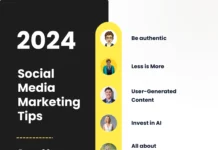Social media might have stolen its limelight, but email remains the professional’s go-to marketing tool. A curated mailing list full of interested parties is riper for conversion than a several times larger social following. This is especially true if you cater to other businesses.
This article details what you need to set up and execute email marketing that attracts new customers and keeps existing ones hooked. You’ll discover what to do at each stage and which tools can help you streamline your marketing endeavors.

A Comprehensive Guide to Email Marketing
Checklist of the Best Practices
In the following sections, a step-by-step guide will help you understand all of the best practices so that you can optimize your email campaigns. Additionally, we will look into some of the best tools that are being used by the majority of digital marketers in the landscape.
Create an Email Marketing Strategy
Before engaging in email marketing, it’s logical first to ask what you hope to gain from it. More subscribers, better click-through rates, and more sales are natural goals, but they’re not the only ones. Maybe you want to draw attention to a new product launch or strengthen your presence in new markets.
Having an overarching strategy helps you plan subsequent steps faster and with better results. Defining specific goals and tracking associated metrics as the strategy progresses will also help you change your approach if the results aren’t as good as expected.
Attract the Right Subscribers
Holding on to a bloated or inadequate mailing list is a surefire way to pay more for your marketing efforts while reaping fewer benefits.
An engaging and informative landing page is crucial to attracting the right kind of potential customer. It offers a chance to introduce your business, what makes it stand out, and what benefits visitors can expect from your services. Demonstrating how you provide value to other businesses is a shortcut to new leads and eventual sales.
Further, your website should also incentivize visitors to join your mailing lists. Again, providing value is critical. Discount coupons will help, but it’s better to offer something prospects can take away even without traveling further down your sales funnel. Such lead magnets include free courses, webinars, workbooks, and other perks accessible only after signing up.
Use this opportunity to find out more about your leads. If you offer various goods or services, ask them which ones they are most interested in. Inquire about their email preferences so they don’t feel like you’re spamming. You can integrate these questions and more into the sign-up sheet.
Albacross
Albacross is an invaluable tool at this stage. It analyzes the traffic your site is getting and filters out companies. It then displays insights about the companies’ size and niche. Even if they don’t sign up, you can use this info to get contact information and reach out. Since they showed initial interest, it’s only natural!

Pros
- Intuitive, easy-to-operate user interface
- Displays practical insights for B2B and B2C
- Has CRM integration
Cons
- Limited contact detail can be revealed
- Sometimes contact list doesn’t sync properly with Google Analytics.
Nurture Your Connections
Like any relationship, the ones you build with potential clients will be more successful the more attention you pay to recipients and their needs.
- Use a two-step opt-in process. Doing so will send a confirmation email with a link the recipient needs to click to make it to your mailing list. This prevents it from ballooning with bogus sign-ups while ensuring consent and compliance in the case of regulations like the GDPR.
- Send a welcome email. When sending out such emails, use the info you gained via the sign-up to address recipients by their or their company’s name. The welcome email should reveal more details about your company’s journey and mission. It’s the perfect means of showcasing some of your best-selling or most relevant products. While at it, throw in a timed welcome bonus or discount to entice quicker conversion.
- Make unsubscribing as painless as possible. Ensure that your email campaigns include a prominent and clearly visible unsubscribe link. This allows recipients to easily locate and click on the link when they no longer wish to receive your emails.
Drip
The welcome email should also be the start of a drip campaign. Drip campaign entails sending follow-up emails after fixed periods and works well when marketing to companies. Here, you can use an email marketing tool, unsurprisingly called; Drip. It’s a tool that specializes in creating and automating drip campaigns.

Pros
- Flexible automation and workflow
- Advanced and visually appealing automation builders
- Offers “Liquid Templating”, which helps highly targeted campaigns
Cons
- Lacking CRM functions compared to its market rivals
- No ability to test variations in email content
Carefully Craft Your Emails
Designing email recipients will want to click on is a science as much as it is an art. Even though you’re catering to companies instead of individuals, many of the same principles still apply. For starters, ensure that any email you send contains the logo and aligns with other aspects of the brand, like your color scheme. Include a signature at the bottom so it’s clear the email isn’t coming from a faceless company.
Subject lines should be short and informative, with preview text serving as the hook. Even though our scrolling habits are changing, the most relevant info and CTA should still be visible without scrolling. Don’t make the email body long-winded; use appropriate yet approachable language. It’s tempting to pepper emails with industry lingo. Refrain from that unless you’re sure your niche audience would appreciate it.
MotionMail
Some specialty tools might make your emails even more intriguing. MotionMail is one of them. It lets you embed countdown timers. These make emails more dynamic while urging the recipient to take action.

Pros
- Easy to use;
- Excellent customer support
- Both free and paid versions
- No Javascript or similar programming language is needed
- Great for creating urgency and integrating dynamic content to email campaigns
Cons
- The test system for the countdown timer might be slow
- The free version allows only a limited amount of visits
Segment Your Audience and Follow the Data
A successful sign-up campaign can yield thousands of contacts with diverse preferences and requirements. Segmenting them into categories and adapting your marketing campaigns to each will speak to more contacts and improve your stats.
You can use different criteria for segmentation. One way to segment individuals is by age, education, and professional occupation. For businesses, it makes more sense to factor in their niche or the level of engagement they demonstrated so far. The latter is convenient since it lets you reassign prospects if their engagement changes.
Having lots of leads to work with also enables experimentation. A/B testing is a popular approach that splits contacts into groups. One continues to receive your regular newsletters. The other gets altered versions of these messages. These can have different copies or promotions, a new layout, unusual sent times, etc. If the new approach shows better results, you can make it the default.
Mailchimp
All the major email marketing suites offer features like easy template creation, campaign automation, segmentation and A/B testing, or scheduling. There are some differences, though. For example, amongst the most well-known Mailchimp has E-commerce integration.

Pros
- Has a simple interface
- Offers more than 500 integration & add-ons
- A free version is available
- Rich segmentation options for your audience
Cons
- Some of the subscription plans can be costly
- There is no email scheduling on the free plan
The more such tools you use, the more features you can take advantage of.
While you’re already expanding your virtual tool belt, add a password manager to the list. If you want to generate a strong password quickly, try the password generator by NordPass. It will provide as many complex passwords as all your team members need to access these tools more securely.
Conclusion
The right approach to your business’s email marketing can transform customer engagement and satisfaction, not to mention your bottom line. Apply the tips and try the tools we mention above. When they start showing results, don’t forget to track what works and optimize your steps for even more successful marketing campaigns in the future.
See also: Best email automation tools this year











